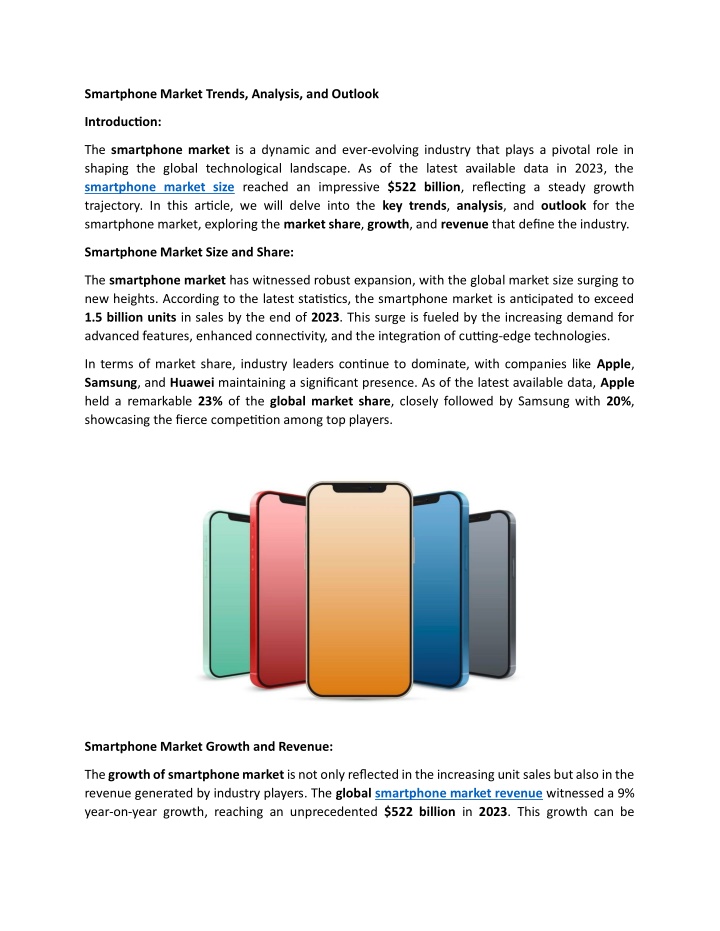
Smartphone Market Trends, Analysis, and Outlook
The smartphone market size reached an impressive $522 billion, , the smartphone market is anticipated to exceed 1.5 billion units in sales by the end of 2023.
Download Presentation

Please find below an Image/Link to download the presentation.
The content on the website is provided AS IS for your information and personal use only. It may not be sold, licensed, or shared on other websites without obtaining consent from the author. If you encounter any issues during the download, it is possible that the publisher has removed the file from their server.
You are allowed to download the files provided on this website for personal or commercial use, subject to the condition that they are used lawfully. All files are the property of their respective owners.
The content on the website is provided AS IS for your information and personal use only. It may not be sold, licensed, or shared on other websites without obtaining consent from the author.
E N D
Presentation Transcript
Smartphone Market Trends, Analysis, and Outlook Introduction: The smartphone market is a dynamic and ever-evolving industry that plays a pivotal role in shaping the global technological landscape. As of the latest available data in 2023, the smartphone market size reached an impressive $522 billion, reflecting a steady growth trajectory. In this article, we will delve into the key trends, analysis, and outlook for the smartphone market, exploring the market share, growth, and revenue that define the industry. Smartphone Market Size and Share: The smartphone market has witnessed robust expansion, with the global market size surging to new heights. According to the latest statistics, the smartphone market is anticipated to exceed 1.5 billion units in sales by the end of 2023. This surge is fueled by the increasing demand for advanced features, enhanced connectivity, and the integration of cutting-edge technologies. In terms of market share, industry leaders continue to dominate, with companies like Apple, Samsung, and Huawei maintaining a significant presence. As of the latest available data, Apple held a remarkable 23% of the global market share, closely followed by Samsung with 20%, showcasing the fierce competition among top players. Smartphone Market Growth and Revenue: The growth of smartphone market is not only reflected in the increasing unit sales but also in the revenue generated by industry players. The global smartphone market revenue witnessed a 9% year-on-year growth, reaching an unprecedented $522 billion in 2023. This growth can be
attributed to factors such as the introduction of 5G technology, rising consumer disposable income, and a continuous influx of innovative features and designs. The integration of 5G technology has been a game-changer, driving higher demand for smartphones with enhanced connectivity and faster data speeds. This technological shift has not only fueled market growth but has also opened new opportunities for manufacturers and service providers to capitalize on the evolving needs of consumers. Smartphone Market Trends: Several trends are shaping the smartphone market, influencing consumer preferences and industry dynamics. One notable trend is the increasing focus on sustainability and eco-friendly practices. Consumers are becoming more conscious of the environmental impact of electronic devices, prompting smartphone manufacturers to adopt eco-friendly materials, reduce packaging waste, and implement recycling programs. Another prominent trend is the continuous evolution of camera technology. Smartphone manufacturers are investing heavily in improving camera capabilities, including advanced sensors, artificial intelligence (AI) enhancements, and innovative shooting modes. The emphasis on camera technology reflects the growing importance of photography and videography in the smartphone user experience. Smartphone Market Analysis: A comprehensive analysis of the smartphone market reveals the importance of adapting to changing consumer behaviors and technological advancements. The rise of affordable and feature-rich smartphones in emerging markets is a significant factor driving global sales. Additionally, the shift towards online sales channels, coupled with aggressive marketing strategies, is reshaping the retail landscape for smartphones.
The increasing prevalence of subscription-based models and finance options is another aspect of the market analysis. Smartphone manufacturers are providing consumers with flexible payment plans and trade-in programs, making high-end devices more accessible and affordable. Smartphone Industry Top Players: The competition among top players in the smartphone industry remains intense. Apple, known for its premium devices and ecosystem, continues to capture a substantial market share. Samsung, a key player with a diverse product portfolio, remains a strong contender. Huawei, despite facing challenges, maintains a significant presence, especially in the Asian market. Other notable players in the smartphone industry include Xiaomi, Oppo, and Vivo, which have gained popularity for offering feature-rich devices at competitive price points. The industry's dynamism is characterized by continuous innovation, strategic partnerships, and a focus on meeting the diverse needs of global consumers. Smartphone Market Outlook: Looking ahead, the smartphone market is poised for continued growth and innovation. The deployment of 6G technology is on the horizon, promising even faster data speeds and more advanced connectivity. Furthermore, the integration of augmented reality (AR) and virtual reality (VR) features is expected to redefine the smartphone user experience. As the smartphone market evolves, manufacturers must stay attuned to consumer preferences, environmental concerns, and technological advancements. The industry's ability to navigate these dynamics will determine its resilience and competitiveness in the years to come. Conclusion: In conclusion, the smartphone industry is a dynamic and thriving industry, with a global market size surpassing $522 billion in 2023. The interplay of market share, growth, revenue, trends, analysis, and the top players underscores the complexity and competitiveness of the sector. As the industry continues to evolve, it is crucial for stakeholders to adapt to emerging trends, leverage innovative technologies, and prioritize sustainability to ensure sustained success in this ever-changing landscape.






















